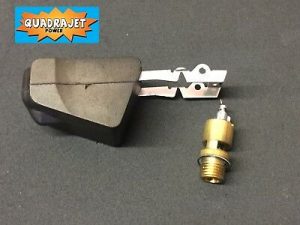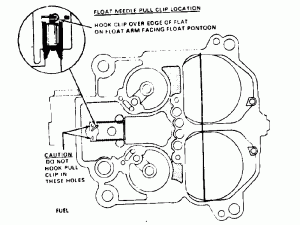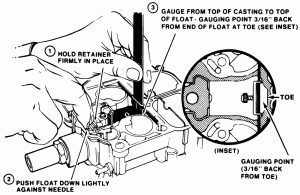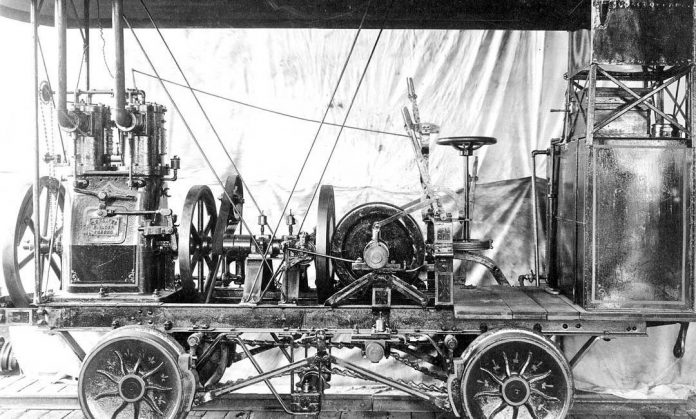If you’re under 40 and thinking about buying a car that’s older than you are, there are some things you may not know about – but will need to learn about if you want to tune that car.
Which will likely have a carburetor, if it was built before circa 1985 and will almost certainly (there a few exceptions) have a carburetor if it was made before 1980.
Carburetors are mechanical rather than electronic fuel delivery devices. A few of the latter stragglers installed just before the general adoption of electronic of fuel injection in the early/mid-1980s have some very primitive electronic controls grafted onto them. But even they are still fundamentally mechanical.
Which means you make adjustments – using mechanical tools like screwdrivers and even your fingers and by feel as well as by measuring. It is both an exact as well as an inexact science.
Which is part of the fun!
One of the adjustments you’ll need to learn to make is setting the float level.
A carburetor works not unlike your toilet, which has a valve that opens to let water fill the reservoir – and then closes when the proper level is reached.
Assuming the valve and float are working and set correctly. If not, the toilet just keeps on filling up and . . . you know the rest.
Carbs operate similarly. The fuel entry valve is called the needle and seat. Gasoline flows through the seat, which is essentially a check valve consisting of a hollow fitting inside the carburetor with the flow of fuel controlled by the needle and the needle controlled by a float.
As the fuel level rises, so does the float – which is the carburetor equivalent of the balloon that floats on the water and rises with the water level inside your toilet
As it rises, it closes off the flow of fuel by seating the needle.
When the fuel level drops – as the engine consumes it, the float drops – and the needle opens, admitting more fuel.
The trick is getting it adjusted such that the right amount of fuel – not too much and not too little – is held in the reservoir of fuel (this is called the bowl) where the float floats. If the float level is too low, the car will experience fuel starvation/lean-out as you accelerate – or try to. The car may buck and surge as the bowl runs low (or dry). If the float level is too high, the carb may flood – and the engine chokes on its own fuel. It may be hard to start; it may not start at all. Or it might run very rich – and roughly – with black smoke coming out of the exhaust pipes.
This is why the first thing to check if you have a carbureted car that’s not running right is the float level. Because if it’s not set just right, not only will the car not run right, you won’t be able to figure out what else is wrong – if anything else is.
It’s not uncommon to blame a problem on things besides the float level – and pursue a wild goose chase in search of a fix that isn’t needed. And by fixing what isn’t broken, making more problems.
But why is adjusting the float a trick?
Because you sometimes have to play with it to get it set just right.
While there are factory specifications for float height – a service manual for the vehicle will give you the exact factory specification in fractions of an inch as well as how to measure it for your particular car – and carburetor – you may need to adjust the level differently to get the carb (and car) to run right.
This is because cars made 40 years ago were designed to run on the gas made 40 years ago, which was gas – not 10 percent ethanol, which results in a leaned-out mixture that requires more gas as a compensatory measure. Also, if the car you’re working on has been modified for increased performance, that will often require adjustment of the float level, too.
And the adjustment, whatever the specification, is done by hand – by very slightly, almost imperceptibly, bending the float’s tangs just a little this way – or that way – to get the thing to hang just right. This is . . . tricky. You don’t pull codes – or “flash” the computer.
It’s a fingers and finesse thing.
Which is . . . fun!
There is a primal satisfaction in getting your carb set just right, via careful trial and (at first) error. You’ll get better as you go and if you have patience at first. What seems a weird science isn’t really. But it is an ancient science – 40 something years in the rearview – and those who aren’t 40 or older today aren’t used to fingers and finesse, to fiddling with mechanical things as opposed to pulling and replacing electronic things.
But we are entering weird times – and being able to fix mechanical things could be more than just fun when you can’t buy replacement electronic things anymore.
. . .
Got a question about cars, Libertarian politics – or anything else? Click on the “ask Eric” link and send ’em in!
If you like what you’ve found here please consider supporting EPautos.
We depend on you to keep the wheels turning!
Our donate button is here.
If you prefer not to use PayPal, our mailing address is:
EPautos
721 Hummingbird Lane SE
Copper Hill, VA 24079
PS: Get an EPautos magnet or sticker or coaster in return for a $20 or more one-time donation or a $10 or more monthly recurring donation. (Please be sure to tell us you want a magnet or sticker or coaster – and also, provide an address, so we know where to mail the thing!)
If you’d like an ear tag – custom made! – just ask and it will be delivered.
My latest eBook is also available for your favorite price – free! Click here. If that fails, email me at [email protected] and I will send you a copy directly!












Weber carburetors are fun to work on, old school tech. I recently bought a super 7 clone, it had a weber 34 carb on it, the quote to rebuild it was about $200 for parts plus about $600 labour, the rebuild kit is $40 so I decided to do it myself. Then I found a Weber 40 dfi 5 which was made for a 365 Ferrari so I bought that and installed that, it has synchronous barrels (2 barrel), flows 363 cfm, better performance and response. That car has points and condenser, no vaccum lines, no power steering or brake booster, no heater, manual choke, exhaust system has one muffler only, totally analog.
It is similar to a 1913 Bugatti type 22 which was even more analog, no starter, no generator, no distributor it had a magneto which is more reliable, it had lights that ran off a replaceable battery, cars are too complicated now.
Actually while the mystery of carbs can be baffling to them (what’s a choke??), I’ve found that for youngsters encountering old vehicles for the first time the mystery of adjusting ignition points and timing is what really spooks them!
Hi Jason,
Ah yes! I think I will do an an article about that using my ’75 Kawasaki S1 as the guinea pig. This beast has three sets of points. One for each cylinder. Gotta love Kawasaki. The “triple” is really three independent singles on a common crank, but each with its own separate ignition, fuel and exhaust system.
I love the damned thing!
The “old-school” methods of tuning a gasoline engine involved ARTISTRY, although, yes, it helped to READ THE MANUAL and FOLLOW INSTRUCTIONS. A particular make and/or engine family had its own characteristics, and individual cars tended to have a “personality”! One learned how to “play” with float level settings, choke pull-off, point gap AND ignition timing, and, for quite a few engines that still used solid tappets, valve lash. I recall with the Carter carburetors that were typical with Mopars, whether they were the ubiquitous Ball&Ball one or two barrels, or the infamous “Thermo-Quad”, you got a MOPAR branded carb rebuild from NAPA or mail order from Honest Charley’s, whom didn’t always have the particular make, especially the later carbs with the vacuum fittings for all sorts of emissions devices, so you’d pay through the nose and order it from the “stealership” parts department. It was WORTH it, though, because you got a lot more choices for things like main jets, and a SPARE needle/seat assembly and top gasket. Anyone’s who’s ever screwed around with a Thermo-Quad knows why you wanted spares of those items! A simple “trick” was that Carter typically made at least three jet sizes, and sometimes more, for a particular carb line. Experience with your particular climate, altitude that the vehicle would typically see service in, and so on let you know which to use. There were other things where a “slight” deviation from factory specs improved performance and/or fuel economy, like advancing timing on a Slant Six a few degrees as the engine put on miles to accommodate timing chain stretch.
All that “artistry” has largely gone by the wayside, as car makers did have to put more strict quality control on engine production to get one to hold up for the lengthier warranty periods that are typical these days, as well as operate with leaner fuel/air ratios to meet fuel economy and/or emissions standards. Of course, the one “improvement” has been the elimination of a mess of “plumbing” of vacuum hoses and related gadgets, as pneumatic controls have yielded to electronic devices and on-board computers. Hence the OBD-II we usually see these days. It makes many “mechanics” little more than someone trained to check the “codes” and replace parts as the program directs. With most of the programming inaccessible, and typically any “fiddling” would be not only futile but counter-productive, the modern mechanic, even of the “shade tree” variety, has become little more than a meat-covered robot.
Another fine article from a true classic car lover.
We MGB owners understand the tick-tick-tick of our electric fuel pumps. Turn the ignition key, listen for the ticks, wait until the fuel pump has filled the float bowls. Then, engage the starter.
Starts (almost) every time. :>)
Thanks, Anon!
I needed a break from Sickness Psychosis… hoping it helps distract others for a bit, too 🙂
Classic car lover my ass! A lot of things need mechanical adjustment for their fuel delivery including big rigs and all sorts of equipment.
Now I’m not knocking eric here, as he well knows, but those who think it only pertains to carburetors are just ignorant. I’d give lessons…..for free…in mechanical fuel injection pump adjustment.
I’ve never had the honor of adjusting an old Merc diesel but I’d love to try. And all those diesel engines of all sorts respond to an adjustment just from mileage.
The old 6.5 Turbo Diesel everyone dissed because they had less power but lasted a long time and got better mileage than other contemporary engines are in need of adjustment as it says right there in the owners manual at 100K. Nothing the matter with that and it will make them get better mileage and increase power and simply run more smoothly.
We don’t want to stop there though. All those diesels in big rigs too are helped greatly when adjusted as they add miles and time.
You can take a Cat 3407B and put it up beside the C and E models that are electronic and it’s like night and day. It’s damned hard to adjust those electronic diesels but the old mechanical diesel will go from that thump thump thump to simply purring.
A buddy of mine had an almost identical Peterbilt 379 with a 3406 B compared to my one year newer Detroit 60 series, a hell of a long lived engine but rarely turned up to the power of a Cat although I’ve had friends with 600 hp 60 series that would run over 115 using the same rear gears and transmissions.
One day my buddy stopped me after a rear diff change and a 3 axle adjustment. He’d had a tick tick tick going on in the engine that’s common with Cat’s that have weights on the cam system and when they come lose they are roaming around in there going shh shh shh but sorta harder than that. He replaced the gears and counterweights and had a guy do a tune up on that mechanical injection. I didn’t know it at the time but he walked me around to the front and said “listen” and I listened and that Cat was so smooth it sounded like a motor turning a fan, just pure beauty.
It was so smooth that we started filling up at the end of the day running the same mileage and I’m running a 60 series Detroit with a 10 speed(big fuck up I’d never have if it were mine) and his Cat with a 13 speed tranny. Every day it was the same thing and part of this was the difference between having a 10 speed and a 13 speed but whatever you wanted to call it, we both ran 80,000 gross every load, that Cat got 6 mpg and the electronic 60 series got 5mpg……even, for both of them.
I love mechanical injection and will hopefully someday be running a GM 6.5 again and getting that sweet idling and great mileage of the mechanical injection.
I had a 1992 mk 2 VW Golf with a 1.6 lt. NA diesel, it had mechanical injection so no computers, after a nuclear war emp it would still run. no computer, diesels can run on various fuels, cooking oil, 50% used engine oil. etc., it got 40 mpg city, 60 mpg highway. Later on I had a mk3 VW jetta with the famous 1.9 lt ALH turbo diesel, heavily computerized, with stage 1 tune, it got the same mileage in a heavier car. with stage 3 tune you can get 450 lb ft torque from that engine, they are good swaps for samurai’s or rangers, etc..
TICK, TIck…tic……THWACK!!!!…TICK, TICK, TICK!
Don’t forget the occasional THWACK to the pump with a Wheel Wizard when the contacts get old.
This videos been making the rounds. I hope you all enjoy.
https://youtu.be/Ec-LrW1tSHQ
“he tried to put gas in a tesla”
Shows how stupid people are today……….
That was hilarious.
And jets, don’t forget the jets. Changing them till you’re blue in the face from dropping them in the float bowl (AGAIN!) to get the mains flowing the right mixture. Emulsion tubes, step-up rods, economizer pistons…ah, but once set, that’s it, sweet musical sounds and power aplenty. The only thing injection buys you is driveability below say 3/4 WOT. Above 3/4 WOT, both meter pretty well…unless the intake manifold is crap, like some inline sixes with “log” manifolds, then one injector per cylinder is probably better. Give me a set of SU’s any day for ease of adjustment.
I rebuilt a few carburetors when I was much younger, always follow the steps 1 through infinity then backwards, shouldn’t have any problems.
I find old carburetors that I know are collectible, so I don’t discard them, never throw away old sediment bulbs.
Had to repair the reverse servo in an automatic transmission on a ’67 Ford 2-door hardtop one time. Forgot one little steel ball in the process, had to tear it all back down again to fit the one little steely in there.
Re-assembled it all right back together and it worked. Never argue with success. har
There is an old International grain truck out in the trees, Probably a ca. 1940 model. I doubt I’ll ever resurrect it, just too old, maybe some parts are worth something.
There is also a horse-drawn old road grader out yonder beyond the trees some, the buckboard has rotted away. Just have to replace that and donate the grader to a museum. Maybe not, might need it in the future.
You just never know, you know.
A workhorse has lungs and a stomach, the carburetor and the fuel tank. lol
Amazingly I have rebuilt many carbs and I have never had to adjust a float,,, unless it was a replacement. They always checked out fine.
The inlet needle valve was usually the culprit when gas was coming out the overflow or causing hydro-static lock in a cylinder. Cleanliness is next to godliness in a carb. I have found the ultrasonic cleaner to be invaluable for this. Made a set of GL650 carbs look almost new. Cleaning out pilot jet passages is necessary. Of course all diaphragms, automatic chokes, if any, need inspected, cleaned or replaced. All gaskets and o’rings get replaced. On motorcycles vacuum pistons and bore for the main needle slider needs to be immaculate. And it’s always best to have the manuals as the instructions included in kits are always lacking.
Another tool I found indispensable is the digital camera. I take many, many pictures during disassembly as contrary to popular belief,,, left over parts is not a good thing.
Another trick I learned from my Dad (he’s still with us at age 86), which I remember from helping him fiddle around with the 327 with a Rochester 4 barrel, was to put a standard in-line gas filter ahead of the in-line filter , UPSTREAM from the fuel pump. We improvised a “heat shield” out of a tomato juice can, affixed with some SMS, as the space, even on that massive Chevy Bel Air wagon, was actually a tad cramped under the hood! Another “trick”, one you couldn’t do once catalytic converters became standard, was to run a quart of Dexron slowly down the carb throat before you changed the plugs when doing a tune-up, believe it or not! The purpose of that bit of “redneck tech” was to loosen accumulated carbon deposits, and hell yes, that engine would smoke like a sick diesel for awhile…I’d have to hold the throttle partly open to keep the engine from stalling as Dad would get in and then hold the gas pedal down, then I’d get it and we’d get out of the neighborhood and down Semoran Boulevard (Winter Park, FL) and make a left at the “Bee Line” Highway…by the time we got to the TV towers at Bithlo, the smoke would have cleared and the engine would be a LOT “happier”, and provided Dad was in the mood and a tad flush with cash, there was the drive-in where we’d chow down on burgers, onion rings and shakes (“Don’t tell your mother…”).
Hi Doug!
A trivia nugget: When Pontiac developed the “T/A 6.6” (also known as W72) high-performance version of the 400 V8 as an option for the ’77-79 Trans-Ams, one of the upgrades over the standard 400 was that the fuel line from the pump to the carb was insulated with foam from the factory.
I always added to this by doing what your dad did – removing the factory filter inside the Quadrajet and installing a larger/freer-flowing filter in the line ahead of the carb.
Many people think the mid-late ’70s TAs were slow but even in stock trim, the “T/A 6.6” versions were not that far off the pace of the earlier cars and could be made close without digging too deeply into the engine. The mod that reaped the most rewards with the least effort was to remove the factory two-into-one (Y pipe) exhaust and replace it with a true dual exhaust – without, of course, any cats.
That plus a power tune would get another wise stock “T/A 6.6” Trans-Am with a four speed through the quarter mile in the mid-high 14s, which was not bad and not far off what a factory 1970 Trans Am with a RA III 400 could pull off.
Added another “antique” to my collection last week. Won an auction, and hauled home 1200 lbs of Detroit 4-53 “screamin’ Jimmy” Detroit Diesel. A lot of us have been preparing for this current madness for a while- hopefully some of our preparations work out. The metals are doing nicely, and the business while very slow continues- beats the hell out of government unemployment or a job eating up 50 hours of valuable time a week (of which maybe 8 are productive).
I am plotting a home for the 4-53 already, in an antique medium truck. Diesels like this will run on lots of things in times of scarcity. As will Carbs on gas engines.
You say it right right ken. No gunk, no problem. Mostly just a leaking float if there is a problem. Holley’s used to have a choice of plastic or brass floats and seems like Q J’s did too. Stick to the brass.
A man after my own heart. I’d love that in a 3/4T Chevy of 80’s vintage. You know the first thing that would go wrong? Neither do it. They’re just forever engines.
Carburetor as toilet … good analogy. Including the fact that carburetors have to be cleaned with some strong solvent to remove the unsightly ring around the float bowl, and the gunk in the jets.
When it comes to used cars — recent rather than vintage ones — something bizarre is going on.
According to Manheim, which monitors wholesale auctions, the price of used cars is screaming higher, up 11% from 12 months ago.
https://publish.manheim.com/en/services/consulting/used-vehicle-value-index.html
With record numbers of people collecting unemployment, WTF is going on?
Gov statistics show that thanks to the $600/week federal unemployment bonus, plus PUA aid to some who weren’t covered by regular unemployment, personal income actually went UP as jobs evaporated.
Moreover, manic, Weimar-style money printing by the Federal Reserve — in which they hoover up bonds and even exchange-traded funds, paying for them with kited checks — has spawned bubbles in every asset imaginable, including (now) used cars.
This is the crack-up boom, comrades. The bozo driving our bus — one Jerome Cntl-Powell (Cntl-P for “print”) is smoking crack as he barrels toward a hairpin turn at 100 mph. Should we jump, or ride the bus over the cliff?
Jim, I’ve noticed the windows are tiny and welded shut. Just HTF do I get off it? Tried the back door right off but it turned out to be an engine hatch cover. Kind regards for an answer…..quickly please.